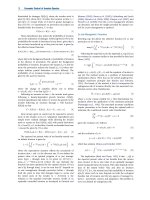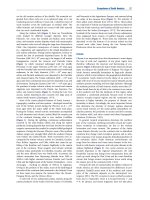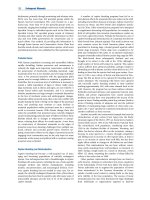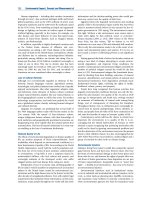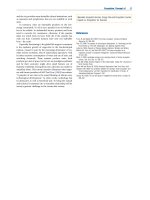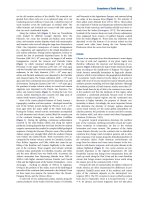Encyclopedia of biodiversity encyclopedia of biodiversity, (7 volume set) ( PDFDrive ) 1601
Bạn đang xem bản rút gọn của tài liệu. Xem và tải ngay bản đầy đủ của tài liệu tại đây (78.79 KB, 1 trang )
18
Economic Control of Invasive Species
diminished by damages D(X(t)), where the invader stock is
given by X(t), where X(t) ¼ 0 before the invasion at time t¼ t
and X(t)40. Greater levels of X lead to greater damages so
that ðq D=q XÞ40. Expenditures on prevention n(t) reduce net
benefits before the invasion, V, so that
VB,n,tị ẳ Btị ntị
ẵ1
These expenditures also reduce the probability of invasion
and so the realization of damages. Following Reed (1987), the
probability the invader is introduced at any time t, given that it
has not been introduced up to that point in time, is given by
the effective hazard function
Johnson (2002), Brown et al. (2002), Lichtenberg and Lynch
(2006), Burnett et al. (2006, 2008), Potapov et al. (2007), and
Finnoff et al. (2010b). First the ex ante management schemes
are discussed, and then the insight provided by optimal control for ex post management is explored.
Ex ante Management: Prevention
Rewriting eqn [6] allows the objective function for ex ante
prevention to be written as
&Z t
'
maxs Et
ert Vn,tịdt ỵ ert JX Xtịị
ẵ7
0
cntị,btịị ẳ limDt-0 fPrInvasion int,t ỵ Dtịjno invasion at tị=Dtg
ẵ2
where b(t) is the background hazard or probability of invasion
in the absence of prevention. The greater the background
probability of invasion, the greater the hazard cb40 and the
more the prevention reduces the hazard cno0 (where subscripts indicate partial derivatives in what follows). The
probability of no invasion having occurred up to time t is
given by the survivor function
Z t
cntị,btịịdv
ẳ eytị
Sp tị ¼ e 0
½3
where the change of variables allows one to define
y ẳ cn,bị, y0ị ẳ 0 so that Sp(0)ẳ 1.
Following an invasion at time t, the invader stock grows
following a density-dependent growth function F(X(t)).
Control expenditures h(t) reduce or reverse the growth in the
invader following an invasion through a ‘‘kill function’’
K(h(t)) so that
X ẳ FXtịị K htịị, Xtị ẳ Xt , t A ft,Ng
½4
More money spent on control can be expected to remove
more of the invader, so Kh40. Adaptation expenditures a(t)
simply lower realized damages while allowing the invader
stock to remain so that D(X(t), a(t)) with partial derivatives
DX40 and Dao0. Let the flow of social net benefits from time
t onward be given by VX so that
VXB,X,a,h,tị ẳ Btị DXtị,atịị htị atị
ẵ5
The expected net present value of net benefits earned over
an infinite horizon is given by
&Z t
'
Z N
ert VXX,a,h,tịdt
ẵ6
ert Vn,tịdt ỵ
J ẳ Et
0
t
where the expectations operator reflects the uncertainty of
invasion time t and r is the discount rate. If one defines the
present value of an optimal program of ex post manageÃ
ment from
R N t through time to be given by JX Xtịị ẳ
max h,a t ert VX X,a,h,t ị dt (where the star indicates the
function has been optimized by the optimal choices of hÃ(t)
and aÃ(t) through time), it can be seen that JXÃ depends on
ex ante management through prevention before t through
both the point in time that damages begin to accrue and
the initial stock of the invader in t. JX Ã(X(t)) is the
solution to the standard renewable resource model of an
optimally controlled invasion as developed in Eiswerth and
Following the steps laid out in the Appendix A, eqn [7] can
be rewritten in a manner similar to that provided by Reed and
Heras (1992)
Z N
ẵVn,tị ỵ cn,bịJX Xtịịertytị dt
ẵ8
J ẳ max
n
0
subject to y ẳ cn,bị, y0ị ẳ 0, and the equation of motion in
eqn [4]. The method results in a problem of deterministic
optimization (Reed, 1987) that can be solved applying Pontryagin’s maximum principle (see Kamien and Schwartz,
1991). The beauty of the method is that it incorporates the
endogenous risk of invasion directly into the associated conditional current value Hamiltonian
H ẳ Vnị ỵ cn,bịJX ỵ rcn,bị
ẵ9
where r is the costate variable for y. This deterministic formulation allows the application of the maximum principle
(Pontryagin et al., 1962). The associated necessary conditions
require prevention to be chosen along the optimal path to
maximize the conditional current value Hamiltonian
qH
ẳ V 0 nị ỵ cn ẵ JX ỵ r ẳ 0
qn
ẵ10
given the evolution of y follows
y ẳ cn,bị, y0ị ẳ 0
ẵ11
and the evolution of r is
r ẳ rr ỵ cn,bịị ỵ Vnị ỵ cn,bịJX
which has solution (Horan and Fenichel, 2007)
Z N
rtị ẳ
ẵVnị ỵ cn,bịJX erstịystị ds
t
ẵ12
ẵ13
The implication (Reed and Heras, 1992) is that r(t) is
the expected present value of net benefits from the current
time onward, or the ex ante value of an optimally managed
system facing the threat of invasion. This value depends on the
state of the system before V(n) and after an invasion
JXÃ(X,aÃ,h Ã) (i.e., the severity) and the probability of invasion
c(n,b), where each in turn depends on both the ecological
baseline risk of invasion and the key aspects of manager behavior – prevention, control, and adaptation. The problem is
now one defined by endogenous risk.
